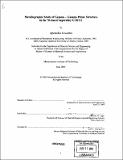Metallographic study of gamma - gamma prime structure in the Ni-based superalloy GTD111
Author(s)
Kountras, Apostolos, 1970-
DownloadFull printable version (12.96Mb)
Other Contributors
Massachusetts Institute of Technology. Dept. of Materials Science and Engineering.
Advisor
Thomas W. Eagar.
Terms of use
Metadata
Show full item recordAbstract
The potential for land-based turbine buckets material rejuvenation presents a significant commercial and scientific interest. Ni-based superalloy GTD111 is used at a number of GE-manufactured power generation turbines. The outstanding creep resistance features of Ni-based superalloys can be attributed to a large extent, to the gamma prime ([gamma]') precipitates found within the FCC [gamma]-matrix. Service-induced material degradation mainly involves coarsening and shape transformation of [gamma]'-phase precipitates; therefore, any bucket repair attempt should primarily address the restoration of [gamma]' precipitates to the original configuration. In the present study a quantitative metallographic analysis of GTD111 alloy under different conditions was performed. Several micrographs were taken and analysed using image analysis software. Gamma prime precipitate size was measured and compared between the different alloy conditions, leading to useful conclusions concerning material degradation as a result of high-temperature service exposure. In addition, microstructural transformations observed as a result of different heat treatments, formed the basis for investigation of procedures that can potentially restore the alloy microstructure in the original condition. High temperature solution and aging heat treatments sequence is considered as potentially sufficient for restoring the GTD111 microstructure. Finally, the measurements were examined for correlation with existing [gamma]' particle coarsening theory, by calculating and evaluating the metal service temperature during service. A satisfactory correlation exists.
Description
Thesis (S.M.)--Massachusetts Institute of Technology, Dept. of Materials Science and Engineering, 2004. Includes bibliographical references (leaf 73).
Date issued
2004Department
Massachusetts Institute of Technology. Department of Materials Science and EngineeringPublisher
Massachusetts Institute of Technology
Keywords
Materials Science and Engineering.